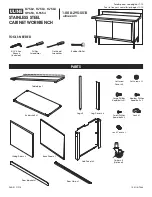
create unacceptable pressure loss in the secondary circuit and reduce the water
flow, reducing the heat removal capabilities of the heat exchanger.
For information about a supplier of these hoses, see “Secondary cooling loop parts
and services information” on page 88. Use solid piping or tubing that has a
minimum inner diameter of 19 mm (0.75 in.) and the fewest possible joints
between a manifold and a heat exchanger in each secondary loop.
You can use quick-connect couplings to attach the hoses to the distribution
manifolds. You must use quick-connect couplings to attach the hoses to the heat
exchanger. Hose couplings that connect to the heat exchanger must have the
following characteristics:
v
The couplings must be constructed of passivated 300-L series stainless steel or
brass with less than 30% zinc content. The coupling size is 19 mm (0.75 in.).
v
The supply hose must have a Parker (male) quick-coupling nipple, part number
SH6-63-W, or equivalent. The return hose must have a Parker (female)
quick-connect coupling, part number SH6-62-W, or equivalent.
v
At the opposite (manifold) end of the hoses, use similar quick-connect couplings.
However, if you want to use other types of connectors, make sure that positive
locking mechanisms are used to prevent loss of water when the hoses are
disconnected. The connections must minimize water spill and air inclusion into
the system when they are disconnected. You can also permanently attach hoses
to the manifolds by using barbed fittings and clamps.
Raised floor hose requirements and management
On a raised floor, hoses can be routed under the floor tiles and can be brought up
from beneath the rack through special tile cutouts. The hoses are connected to the
quick-connect couplings on the bottom of the heat exchanger.
In a typical example, each heat exchanger requires a special cut 0.6 m
×
0.6 m (2 ft
×
2 ft) floor tile below it with the opening outside of the rack footprint. A portion
of the tile is cut away and correctly covered to protect against sharp edges. The
corner opening is placed directly under the hinge side of the rack rear door. The
opening size of the cut is 152.4 mm wide
×
190.5 mm long ±12.7 mm (6.0 in. wide
×
7.5 in. long ±0.5 in.) in the direction parallel to the door. See Figure 27 on page
84
IBM XIV Gen3 281x-11x, 281x-21x, and 281x-314 Planning Guide
Содержание XIV Gen3 Series
Страница 1: ...IBM XIV Storage System Gen3 Models 281x 11x 281x 21x and 281x 314 Planning Guide SC27 5412 09 IBM...
Страница 6: ...vi IBM XIV Gen3 281x 11x 281x 21x and 281x 314 Planning Guide...
Страница 8: ...viii IBM XIV Gen3 281x 11x 281x 21x and 281x 314 Planning Guide...
Страница 10: ...x IBM XIV Gen3 281x 11x 281x 21x and 281x 314 Planning Guide...
Страница 16: ...xvi IBM XIV Gen3 281x 11x 281x 21x and 281x 314 Planning Guide...
Страница 24: ...xxiv IBM XIV Gen3 281x 11x 281x 21x and 281x 314 Planning Guide...
Страница 52: ...28 IBM XIV Gen3 281x 11x 281x 21x and 281x 314 Planning Guide...
Страница 87: ...AIX 7 Oracle Solaris 11 SPARC Solaris 11 INTEL HPUX HPUX 11i v3 IA64 Chapter 8 Management tool requirements 63...
Страница 88: ...64 IBM XIV Gen3 281x 11x 281x 21x and 281x 314 Planning Guide...
Страница 94: ...70 IBM XIV Gen3 281x 11x 281x 21x and 281x 314 Planning Guide...
Страница 116: ...92 IBM XIV Gen3 281x 11x 281x 21x and 281x 314 Planning Guide...
Страница 125: ......
Страница 126: ...IBM Printed in USA SC27 5412 09...
















































